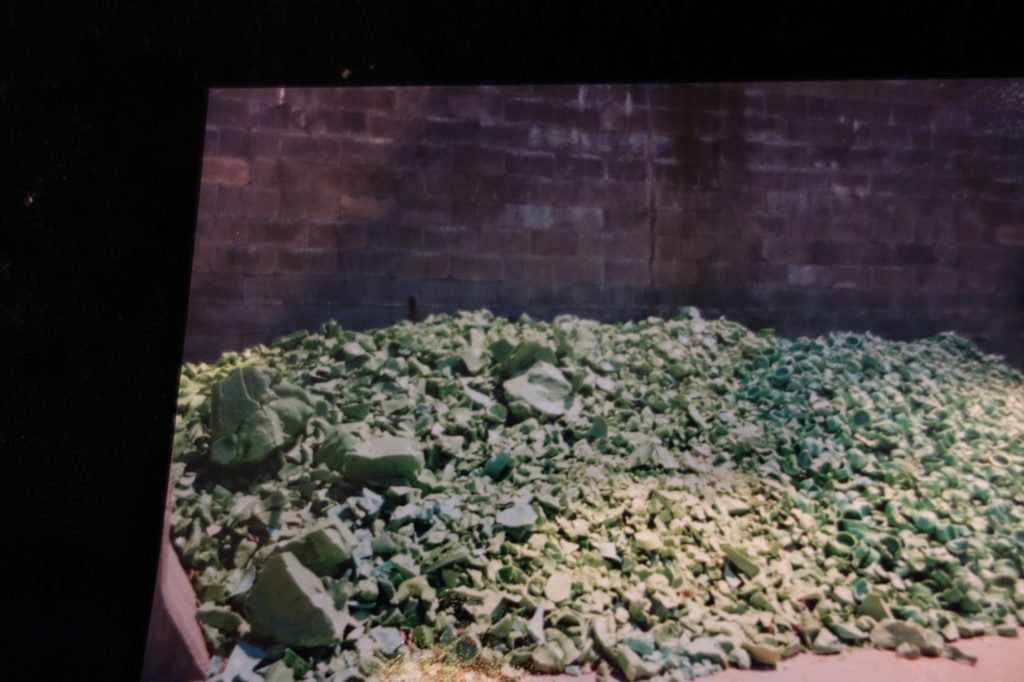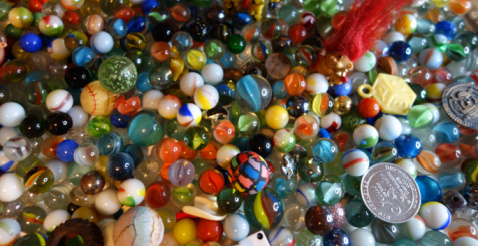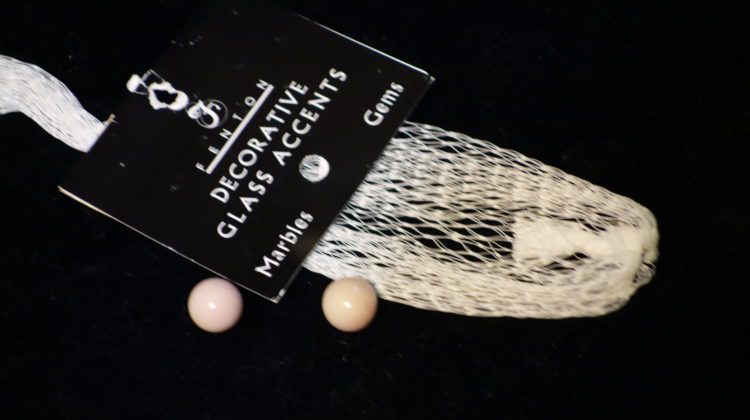
“Be less curious about people and more curious about ideas.” Marie Curie [1]
Doped Marbles & the 2% Club
In our book The Secret Life of Marbles we take a look at one way the American Military used uranium-doped marbles in Cold War weapons testing. That section is called Hot Glass and Moving Targets and it is in “Chapter Five: Sex, Sparkles, and Stop Signs”.
We all know something about “Vaseline” or “Uranium” glass [UV]. It is that older yellow or yellow-green glass which glows green under ultraviolet light. Just check out the first photograph in this post. Wow!
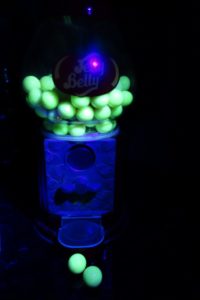
The “original” petroleum jelly dates from about 1880 – 1920s. It was a light yellow in color. At one time every home in America had a jar. In normal light some UV glass is the exact same color as Vaseline. And that is how it came to be called Vaseline glass. Most avid collectors of this glass display it in a case which is lit with a blacklight.
Burmese Sunset
This is the same Jelly Belly® dispenser in normal light. Just look at the difference in this shot and the one at the top of this post which was taken in UV light! Notice that the marbles do not look yellowish: that’s because they are Burmese glass. We will look in more detail at Burmese marbles later in this post.
A few ideas from Michele Alice[2] on uranium glass:
- the neon-green fluorescence indicates the presence of uranium.
- Uranium was discovered in 1789 and between the 1830s and World War II “all manner of objects made of the glass – from everyday drinking glasses, cups, and dishes to decorative pieces and art glass – appeared on the market.”
- We also learn from her that commercial production of uranium glass resumed in 1959 with Federal Government restrictions . Manufacturers switched to depleted uranium, which is less radioactive.
- Older Vaseline glass may contain up to 25% uranium by weigh!
- Modern UV glass such as Burmese contain 2% uranium oxide.
- Fenton Art Glass had to be licensed through the United States Nuclear Regulatory Commission to use Uranium 238 in their glass.
- Uranium 238 was first used by Fenton in Burmese glass in 1970.
- Not all uranium glass looks alike.
- “Burmese glass dates to the 1880’s and is distinctive for the gradual shift from a canary-yellow bottom to a salmon-colored top. This is achieved, in part, through the addition of soda ash, lime, and gold.”
- And, finally, a story which sounds apocryphal to us but which Alice relates in her article: When Burmese glass was first gifted to Queen Victoria (reigned 1837 – 1901) in the 1880s she said that the colors reminded her of a Burmese sunset. While this story of the naming of the glass is also explained by Mary Haberstroh [3] in more detail, it is repeated by almost everyone who has done Burmese research and by Burmese collectors worldwide.
Fenton Art Glass Had a Long & Very Popular Run [4]
Fenton Art Glass was started in 1905 in a rented space in Martins Ferry, Ohio. Martins Ferry is across the Ohio River from Wheeling, West Virginia, and it is in the Wheeling metropolitan area.
Brothers John W. Fenton and Frank L. Fenton opened the company. They were soon attracted to the abundant natural gas in West Virginia and they built and opened a factory in Williamstown in 1906. Unlike a number of glass novelty and marble companies who were vagabonds for many years, Fenton stayed in Woods County for 100 years.
Fenton Art Glass grew and adapted, developing new colors and staying in business through the Great Depression and World Wars. Fenton glass is collected and loved worldwide.
Bringing It Home
We found our Fenton Burmese marbles in a small antique shop in Pace, Florida, in 2006. We were shopping with Larry’s sister Lynn G. Howell and her husband Jim. Lynn had collected Fenton glass for many years and she and Jim had visited Fenton and taken a tour of the operation and gift shop. So, she knew what Burmese glass is and told us all about it.
As you can see, the Fenton Glass marbles came in a plastic mesh net with a simple black and white header card. There were 100 marbles in the bag.
When we bought the bag of marbles we learned that the lady who rented the booth was born in Williamstown. At the time we checked the Fenton online catalog, and we learned that marbles were no longer marketed. We believe that the vendor probably bought this bag while visiting in the area. We have no idea how widely they were marketed outside the area.
Where Did These Come From?
At the time we had no idea which company ran the marbles. We did know, of course, that while made from Burmese cullet, the Fenton glass works itself never produced marbles. Several years later we again researched Burmese glass and then we learned that Marble King, Inc. of Paden City, West Virginia, ran marbles using Fenton cullet.
In response to our inquiry, Beri Fox, President & CEO, Marble King, Inc., emailed us:
“We have done marbles using Blenko Glass, Wissmach Glass and some Anchor Hocking Glass. Fenton is the only company who marketed our marbles under their name.” [6]
Mount Washington Glass Company
While Fenton did not produce Burmese glassware until 1970, it was, as noted above, well known in the Victorian Period. It “was produced and first patented by the of South Boston, Massachusetts. This particular style of art glass utilized heating and re-heating methods after being hand-blown to which uranium oxide was added to the gold in the translucent white glass. Once the glass was finished from being fired in the kiln, it was opaque. This metallic blend created the duo-toned glass in pale yellow and pink, but some pieces were made with brighter yellow and orange.” [7]
And thus Fenton Art Glass, Inc. came to be licensed through the United States Nuclear Regulatory Commission.
Restructuring and a Slow Boat to Closure
Fenton Art Glass began an attempt at restructuring in June 2007, until in July 2011 the Company had to cease traditional glass making and focus solely on being a jewelry making operation while continuing to sell inventory out of their gift shop and give tours of their museum.
During this process, in July 2010, We visited the Fenton Museum and Gift Shop and bought a bag of 100 Burmese glass decorator marbles. If we had had any idea of the situation at the time, then we would probably have bought more. We really like the Burmese glass whether it is backlit or not.
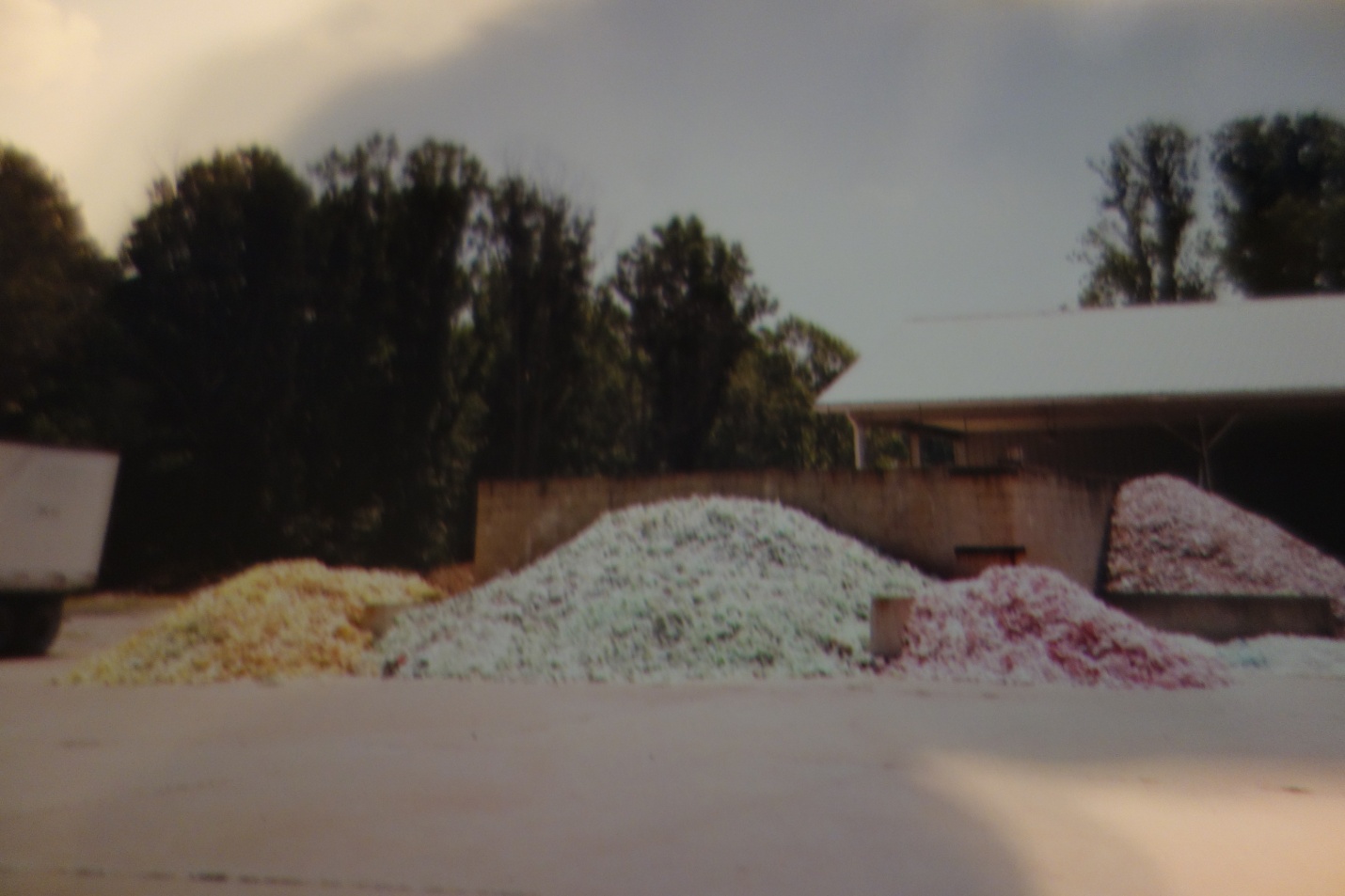
Cullet Yards with Fenton Art Glass Cullet, Williamstown, WV, 2010
The Long and Winding Road for Fenton Cullet
After closing its museum and plant in 2013, Fenton held auctions of glass that were left in Fenton’s inventory. The last auction was held in July 2014.
In May 2014 we visited Sammy Hogue at his shop in Ellanboro, West Virginia. While there, Joanne bought a 1¾” gorgeous handmade marble. He signed it ‘Sam Hogue 2012 May 4 To Joanne.’ We cannot believe that he actually dedicated a marble to both of us! He also decicated the one we bought for Larry’s sister Lynn. This marble is very special. It has external pole to pole ribbons of Burmese glass which Sam got from Fenton. Fenton was auctioning their cullet closing and only making beads at the time. Most long term employees had been let go. Sammy bought the Burmese glass, and made a contemporary treasures out of it!
And, of course, he was not alone in being attracted to the Fenton cullet. Dave McCullough, now owner of Dave’s Appalachian Swirls in Pennsboro, West Virginia, ran “tons and tons” of Fenton glass while at both Champion Agate and Jabo, Inc. Mostly, he continued, it was industrial glass, but there was some art glass, too. Some of the art glass, Dave said, was Burmese and other UV glass. [8]
Marbles in the Wild
The last time we found Fenton cullet and marbles “in the wild” was in August 2019. We found a very old shop in an even older location on the eastern slopes of Blood Mountain in Towns County and north of Helen, Georgia. The entire operation was run by one man and his decrepit old hound. We did enjoy meeting them and exploring. We then saw that the sole proprietor sold large pieces of glass cullet. These were scattered across dozens of tables with wire-mesh tops. The tables rambled down a slope near the shop and inside a wire fence. Also, the table tops were staining the glass with rust.
The owner told us he spent as much time killing copperheads in the cullet yard as cleaning and selling glass! We could understand the problem; there was precious little difference in the mountain slope and the cullet yard!
The shop owner also shared with us that he did know his glass and he said that it was Fenton. We did not have our UV flashlight. But we knew that the last Fenton glass auction in Williamstown was over and that in 2017 their property had been sold to Wood County Schools. So, any Fenton glass which a dealer has is limited.
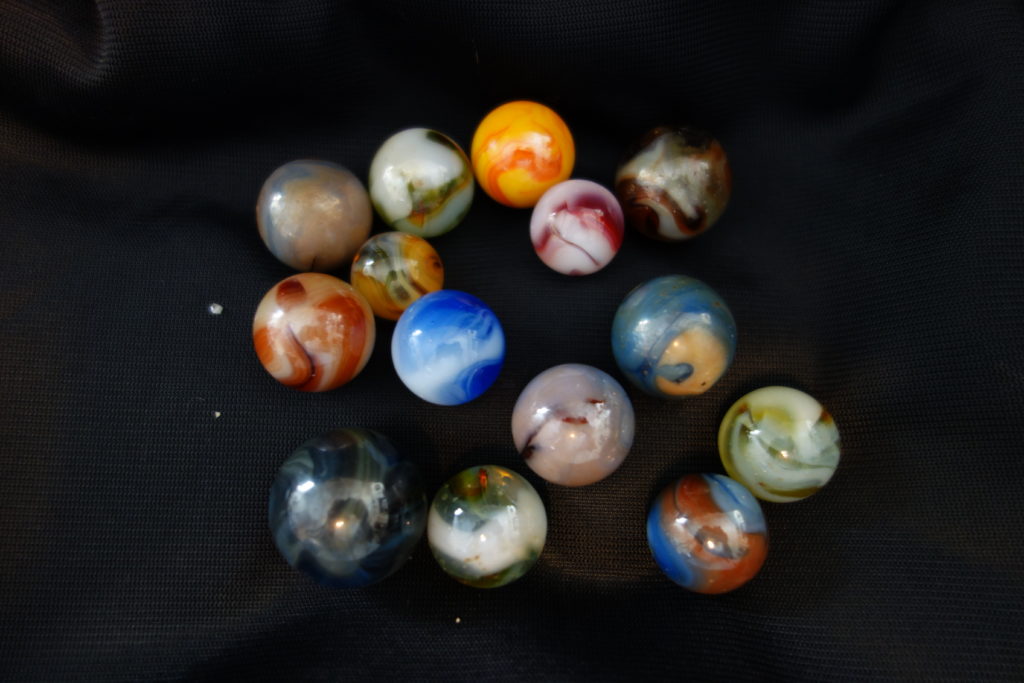
Look What We Found!
Inside the shop, the proprietor also had some glass marbles for sale. Oddly, he said that these, too, are Fenton. We bought 28 marbles in that shop. We knew that some yellow patches which we bought inside are Marble King Rainbows. Outside we found that most of the owner’s marbles were rusty and dirty. We did buy 8 pieces of cullet and are confident that it is Fenton. One is transparent Champaign while two others have lavender and pink shades. We also bought 14 shooters outside. Some of the shooters, once we got them home and cleaned, are very nice translucent.
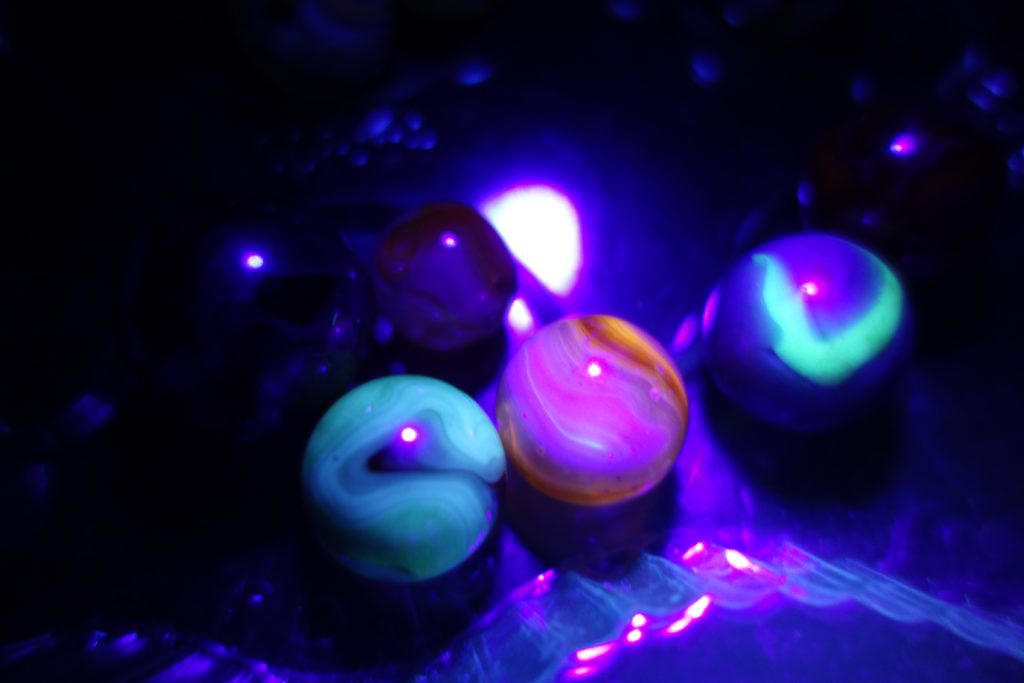
We are confident that Dave made these marbles from Fenton Art Glass UV cullet. We are unsure where we was working at the time.
To Close: $200.00 WHAT?
We said that the last time we found Fenton Art Glass marbles in the wild was in 2019. That’s true. But just days ago we found a small handful of marbles which Dave had run at either Champion or Jabo. They were all gussied up and in a fancy display in an upscale shop on the Alabama Coast.
And they were advertised as UV. We did not check. But the small jelly jar was on sale for $200.00! Can you imagine? And if the seller knows that the glass is Fenton art glass and who ran them and where he or she is not saying.
Auf Wiedersehen, alte Freunde!
Bottom line: Fenton cullet and marbles are out there if you look for it. Burmese glass probably is as well. But the supply is limited and it can never be replenished. And that is the true and sad story about Fenton Art Glass. It is heartbreaking every time we lose another American glass house.
Whether we collect Fenton or any other glass, we are all poorer when a glass shop closes. Something is lost that can never be replaced.
Notes
[1]From: https://wearetechwomen.com/inspirational-quotes-marie-curie-physicist-chemist-pioneer-in-the-study-of-radiation/ 4/5/2022 ) While working alongside her husband Pierre, Marie discovered the elements polonium and radium. In 1911 she won the Nobel Prize in Chemistry for the discoveries.
[2] Michele Alice. “Collectors Corner: Uranium Glass.” EcommerceBytes-Update, Number 319 – September 23, 2012. Online at: https://www.ecommercebytes.com/cab/abu/y212/m09/abu0319/s05 4/5/2022.
[3] Mary Haberstroh. “Burmese Glassware – From the Mount Washington Glass Company to Fenton.” http://www.hobbizine.com/page1084.html 4/5/2022.
[4] Much of this story is from: “Fenton to decommission art glass site in Williamstown.” The P:arkersburg News and Sentinel. 17 July 2016. https://www.newsandsentinel.com/news/business/2016/07/fenton-to-decommission-art-glass-site-in-williamstown/ 3/27/2022
[5] Again, we refer to the 2016 The Parkersburg News and Sentinel story.
[6] Email from Beri Fox, 16 September 2014.
[7] If you want to take a deep dive into all things Burmese glass then check out Mary Haberstroh. Full citation Note [3].

